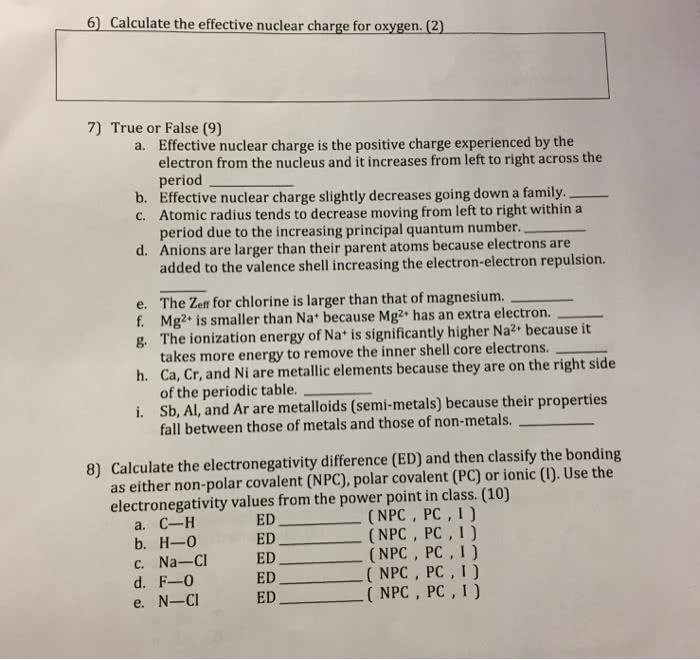CAS CH 171 Lecture Notes - Lecture 2: Sulfur Hexafluoride, Valence Electron, Magnesium Fluoride

10/7-10/24: Unit 2
Bonding
• To achieve a full valence shell (8 electrons)
• Ionic Bonding - transfer of electrons (gain/loss of elections)
• ^needs a large electronegativity difference (large = GREATER OR EQUAL TO 1.9)
• ex: Na (0.9) and Cl (3.0) —> Electronegativity Difference = 3.0 - 1.9 = 2.1
• Cation - element has a net positive charge (loss of electrons)
• charge = the group number
• Metals - more susceptible to lose electrons and become cations
• Anion - element has a net negative charge (gain of electrons)
• charge = 8 - the group number
• to rename elements as anions, you take the stem and add -ide to the end
• ex: chlorine = chloride
• Non-Metals - more susceptible to gain electrons and become anions
• Covalent Bonding - sharing of electrons
• Steps -
• 1. atoms are separated
• 2. orbitals touch
• 3. orbitals overlap and a covalent bond is formed
• *elements in GROUP 4 will not form ions (C/Si/Ge/Sa/Pb)
• *full valence shell (outer shell) = 8 electrons8
ex:
Na - [Ne]3s^1 (1 valence electron)
Cl - [Ne]3s^2 3p^5 (7 valence electrons)
Na —> e- + Na+
Na+—> Na - 1e-
Na- —> Na + 1e-
Cl + e- —> Cl-
Na will lose an electron (Na+), Cl will gain an electron (Cl-)
ex: write the binary ionic compound for K + Br
K+ Br-
answer: KBr
ex: how many mol of F- ions are in 2mol of MgF2?
work: (2mol MgF2) x (2mol F)/(1mol MgF2)
answer: 4mol F-
ex: Na - 1s^2 2s^2 2p^6 3s^1 = [Ne]3s^1
*EASIEST to lose (3s^1) and become a cation which will fully stabilize it
Na —> Na+ + e-
Na+ = 1s^2 2s^2 2p^6 = isoelectronic to [Ne] (isoelectronic - same number of electrons)
ex: Cl - 1s^2 2s^2 2p^6 3s^2 3p^5 = [Ne]3s^2 3p^5
*EASIEST to gain an electron and become an anion which will fully stable it
find more resources at oneclass.com
find more resources at oneclass.com

Cl + e- —> Cl-
Cl- = 1s^2 2s^2 2p^6 3s^2 3p^6 = isoelectronic to [Ar]
ex: draw the reaction to create an ion from Al and write the electronic configuration for that ion.
Al —> 3e- + Al3+
P + 3e- = P3-
Lewis-Dot Structure
• Electrons (single electrons) = represented by dots around element symbol
• Covalent Bonds (shared electrons) = represented by dashes between element symbols
Ionic Compounds
• Binary Ionic Compound - Need the LOWEST ratio of elements to achieve a neutral state
• Rules -
• 1. Molecular formula
• Number of each atom
• 1st atom (not Hydrogen) is the control atom
• 2. Determine the total number of valence electrons
• 3. Put one pair of electrons between each atom
• Subtract that number from total valence electrons
• Use remaining to complete octets of other atoms
• 4. If all octets cannot be satisfied, then more electrons must be shared
• Results in double/triple bonds
• *usually the group number will signify how many bonds will need to be made
Polyatomic Ions
• Atoms held together by covalent bonds
• Overall change
Covalent Compounds
• Rules -
• Name of the first element in the formula
• Use prefixes di- and so forth (if necessary)
• Name of the second element
• Use prefixes mono- and so forth (if necessary)
• Examples (common monatomic anions) -
• H- —> Hydr —> Hydride
• F- —> fluor —> Fluoride
• Cl- —> Chlor —> Chloride
• Br- —> Brom —> Bromide
• I- —> Iod —> Iodide
• O2- —> Ox —> Oxide
• Si2- —> Sulf —> Sulfide
• CO2 = carbon dioxide
find more resources at oneclass.com
find more resources at oneclass.com

• H2O = dihydrogen monoxide
• SO3 = sulfur trioxide
• SF6 = sulfur hexafluoride
ex: CH4
work: C = 4 electrons + H = (1 x 4) electrons = 8 electrons
8e- - 8e- = 0e-
H
|
H - C - H
|
H
ex: CO2
work: C = 4 electrons + O = (6 x 2) electrons = 16 electrons
16e- 8e- = 8e- —> 8e- - 8e- = 0e-
O = C = O (and each of the O atoms have 4 electrons/dots around them)
ex: N2 (in group 5A)
work: N = (5 x 2) electrons = 10 electrons
10e- 2e- = 8e- BUT we need 12e-
SO: 10e- - 6e- = 4e- —> 2 bonds more
N -(triple bond)- N (and each of the N atoms have 2 electrons/dots around them)
ex: O2 (in group 6A)
work: (6 x 2) electrons = 12 electrons
10e- - 2e- = 8e- BUT we need 12e-
SO: 12e- - 10e- = 2e- —> 1 bond more
O = O (and each of the O atoms have 4 electrons/dot around them)
ex: MgSO4
Mg2+ <—> SO42-
work: 6 electrons + (6 x 4) electrons + 2 (from the 2+) = 32 electrons
ex: NH4+
work: 5 electrons + (1 x 4) electrons - 1 = 8 electrons
H
|
[ H - N - H ]
|
H
ex: SO3
find more resources at oneclass.com
find more resources at oneclass.com


